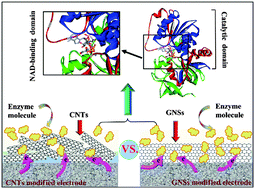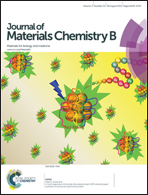Carbon nanostructure modified enzyme-catalyzed biosensor for bio-electrochemical NADH regeneration
Abstract
An efficient and biocompatible NADH regeneration system to promote ADH-catalysed oxidation reactions is reported. Carbon nanomaterials facilitate enhanced enzyme attachment within their hierarchical nano-structure. According to enzyme protein molecular computer simulation analysis, different electron transfer efficiencies on CNTs or GNSs enzyme-catalyzed electrodes result in different electric charge distributions around ADH, which affects its molecular spatial arrangement and three-dimensional conformation. The nanostructure enhances the enzyme–electrode interaction and electron transfer rate. 1.4- and 1.9-fold higher current density are reached on CNTs and GNSs, respectively, versus the carbon cloth control for the bio-electrochemical NADH regeneration. Maximum NADH production rates are 2.11 and 3.01 times higher than that on the unmodified carbon cloth control. The use of the efficient carbon nanomaterial electrochemical reactor leads to a highly conductive three-dimensional cathode for the improvement of bio-electrochemical NADH regeneration, making the nanomaterial an extremely efficient material from an engineering perspective as well.


 Please wait while we load your content...
Please wait while we load your content...